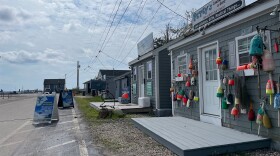New Hampshire communities have a new option for financial help in the wake of a disaster, after a new relief program was signed into law this summer.
The change allows the governor to declare a disaster — as opposed to waiting for the federal government to do so — and allows municipalities to apply for up to $25,000 per year to help with recovery.
It’s meant to give communities access to funding more quickly than the present system, which relies on disaster declarations from the President. Those can come weeks or months after a disaster, with towns and cities paying for immediate repairs out of pocket with the hope they’ll be reimbursed for some of the cost.
Funding through the Federal Emergency Management Agency, which makes up the bulk of the aid towns and cities use to recover from disasters, will still rely on federal disaster declarations.
Climate change is making New Hampshire warmer and wetter, with storms dumping more rain on communities. Extreme precipitation events, which make up most of the federally-declared disasters since Gov. Chris Sununu has been in office, have increased about 60% in the Northeast since the 1950s, according to the latest National Climate Assessment.
Rep. Judy Aron, a Republican from Acworth, sponsored the effort to create the grant program. Her initial bill was killed in the Senate, but the language eventually made its way to Sununu’s desk tucked into an unrelated bill.
Aron knew what it was like for her town, Acworth, to recover from major flooding. Roads throughout her community were washed out in a storm in 2021, and, just as repairs were finishing up, they were destroyed again in 2023.
Recovery took a lot of time, a lot of effort and a lot of money. The town had to apply for a $2.1 million bank loan. That experience, she says, has been relatively common.
“To be able to get a quick infusion of cash from the state would help these municipalities greatly,” she said, “at least to address the costs of temporary work to be done to make roads passable and safe.”
The system in place federally to help communities recover from disasters, managed by the Federal Emergency Management Agency, is notoriously cumbersome and slow (though FEMA and local officials say new efforts to streamline the process have been helping).
Even when federal assistance is available, it’s in the form of reimbursements, meaning a community needs to come up with funding up front to repair roads and bridges and make other fixes.
Two state programs enacted in 2022 – Exceptional Disaster Relief Loans and Disaster Relief Assistance for Municipalities – were intended to help fill the gaps for communities recovering from disasters. The loan program is meant to provide funding to municipalities as they recover and navigate the FEMA reimbursement process. The other assistance program was meant to provide that communities could use towards the costs they share with FEMA, usually 10% to 25%.
But both of those programs rely on a federal disaster declaration; municipalities must have applied for FEMA help before applying for state aid. And in the two years since their inception, neither have dispersed any help to municipalities, according to the state’s Department of Homeland Security and Emergency Management.
Vanessa Palange, a spokesperson for the Department, said officials are still waiting on their legal council to approve the rules for applying for help through those programs. Two communities – Acworth and Roxbury – have written letters to express interest, but no communities have applied for loans, she said.
Aron says she hopes the new grant program will be able to provide more substantial, immediate help for people.
“I think this is a good first step,” she said.
She’s hoping to raise the cap on how much grant funding a municipality can request moving forward (her initial bill included a cap of $100,000, instead of the $25,000 that was signed into law).
And, she says, she’s hoping the state begins to take hazard mitigation – preparing infrastructure for future storms – more seriously.
“If we're going to start having some of these weather changes coming, which produce a lot of rain, we have to start thinking about how to better manage the infrastructure to be more resilient against that,” she said.





